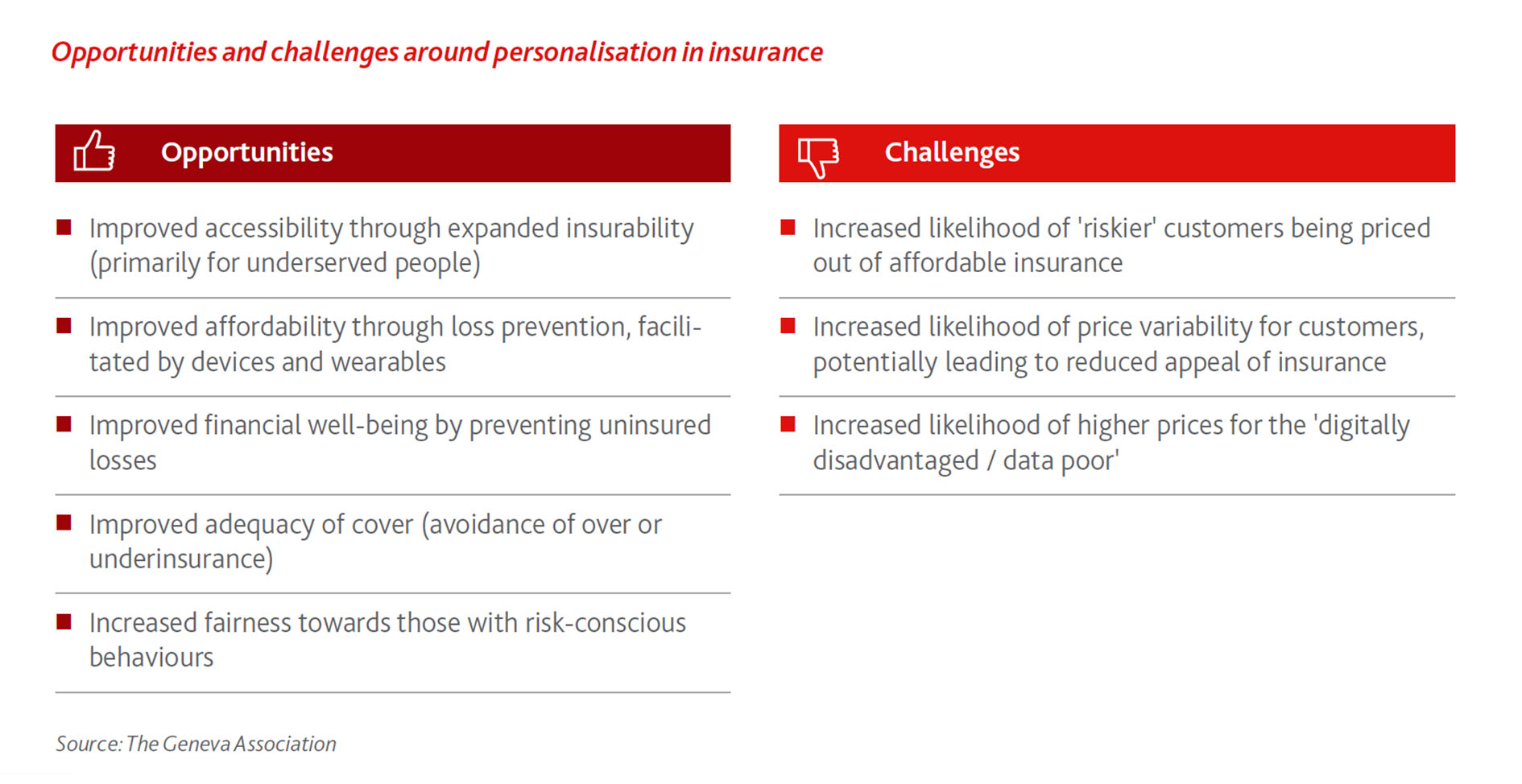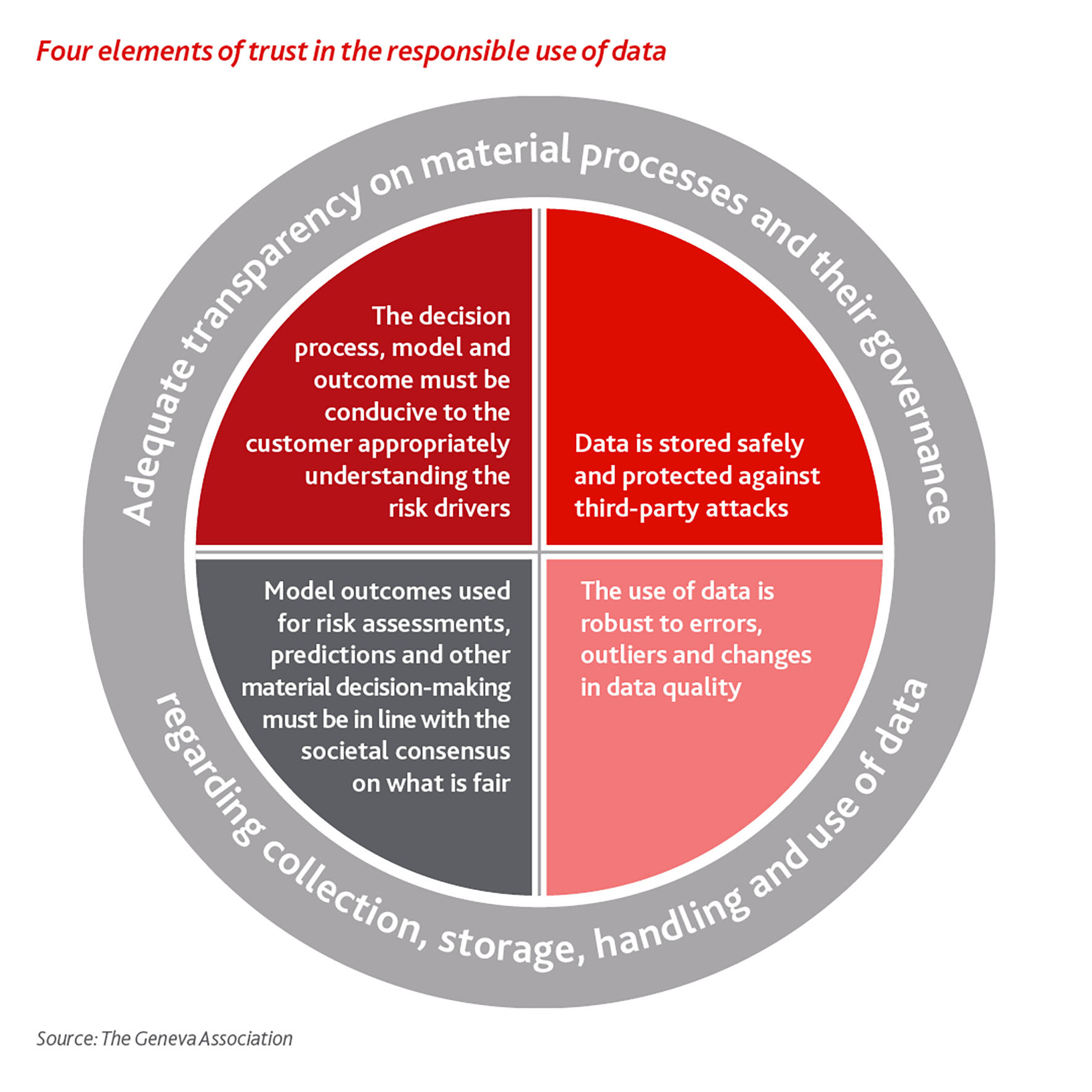The data revolution in insurance: Opportunities and challenges
New digital technologies, artificial intelligence (AI) algorithms as well as quantum leaps in data availability and computational power are transforming what data can be collected and how information can be distilled from it. Increased data granularity can improve risk assessment and risk management, which can in turn increase the availability of and access to insurance, especially for underserved customer segments with difficult-to-assess risk profiles. The ‘data revolution’ can also promote the affordability of insurance and benefit customers’ financial well-being, on the back of much-enhanced loss prevention facilitated by devices and wearables. Based on these advancements, insurers can offer more adequate and tailored coverage, avoiding both underinsurance and overinsurance, as well as premium discounts for those with risk-conscious behaviours.
At the same time, however, customers with riskier profiles (i.e., those with higher loss expectations) face an increased likelihood of being priced out of affordable insurance. The ubiquity of data can also lead to a higher potential for differentiation on the basis of factors seemingly unrelated to insurance (e.g., credit scores), which is often perceived as unfair. Given the sharp reduction in the size of risk pools used in setting premiums, personalisation may ultimately translate into greater price instability for customers, potentially reducing the appeal of insurance. Moreover, reducing a risk cohort to a ‘segment of one’ challenges the core principle of insurance, which relies on the pooling of risks and premiums.
| Figure 1: Opportunities and challenges around personalisation in insurance |
 |
Fairness, discrimination and customer trust
Discrimination can be defined as the unfavourable treatment of a person based on association with a specific social group and the characteristics representing it, e.g., gender, age, disability, ethnicity. Many countries have regulations in place that prohibit discrimination based on some of these protected characteristics. Differentiation based on individual (modifiable) behaviour, however, is widely accepted. A common example is higher premiums for risky drivers.
Fairness is much broader and more difficult to define. It is in general subjective, based on individual, societal and cultural factors. For insurers, it is important that their services are perceived as fair for the sake of brand, reputation and building customer trust. Striking a balance between varying perceptions of fairness and the objective benefits of increased data usage will therefore be key. The level of personalisation in insurance needs to be carefully considered to provide not only the most affordable and suitable coverage for individuals and communities, but also coverage that is considered fair from the consumer’s perspective.
Significant geographical differences exist when it comes to customer expectations around the collection and use of data. In Asia, for example, perspectives are result- and value-driven: people judge the use of data more on the advantages and disadvantages to the person who provides it. In Europe, by contrast, customers prioritise individual freedom and non-surveillance – the individual is at the centre and should therefore be in control of their personal data and information. Based on the findings from in-depth expert and executive interviews, however, the issue brief identifies several essential elements for insurers to foster customer confidence, including transparent communication, safe storage of data and protection against third parties (Figure 2).
| Figure 2: Four elements of trust in the responsible use of data |
 |
Recommendations
In general, customers with a better understanding of insurance products and the factors that influence premiums and insurance coverage have fewer concerns about sharing their data. This highlights the importance of upfront and clear customer communication. Concurrently, insurers should embed strong governance processes for data collection and usage into daily operations to ensure responsible use. Such robust processes are a prerequisite to customer trust in the digital age as well as an important determinant of customer readiness to share data with their insurers.
The issue brief presents five recommendations for the insurance industry to use in its use of data and models:
- Differentiate between data collection and data use
The collection of sensitive variables is needed to test for the risk of bias or discrimination, otherwise it is very difficult to identify and mitigate unwanted biases. Variables that are identified as unsuitable should be excluded from further use.
- Define the responsible use of data first
The responsible use of data and associated guardrails must be defined and implemented by insurers before new data applications and models go live. They should ensure data privacy and put a particular emphasis on non-discrimination and fairness.
- Apply principles-based governance to ensure fair outcomes
A flexible and principles-based governance process should define the most appropriate fairness objective for every single application in the project planning phase. All stakeholders along the value chain as well as risk, compliance, IT and HR departments should be part of the process.
- Implement a framework of trust
Insurers should implement a framework of trust with customers based on data security, the robust use of data, reasonable model outcomes, clear decision processes and models, and transparent and proactive communication with customers on actions around data.
- Engage in debate about fairness and the acceptance of behavioural modifications
To better understand societal perceptions of fairness, regulators and insurers should establish a dialogue with external stakeholders. One proposal would be to establish an independent consumer panel to understand customer perceptions. A more advanced approach would be a multi-stakeholder governance committee to evaluate customer outcomes based on a better understanding of the perception of fairness.
In a complex digital age, trust surrounding the collection and use of data is more important than ever. Insurers should go beyond regulatory compliance and take measures to ensure the responsible use of customer data which, in turn, builds stakeholder confidence. A
Dr Isabelle Flückiger is former director new technologies and data and Dr Kai-Uwe Schanz is head of research and foresight with The Geneva Association.